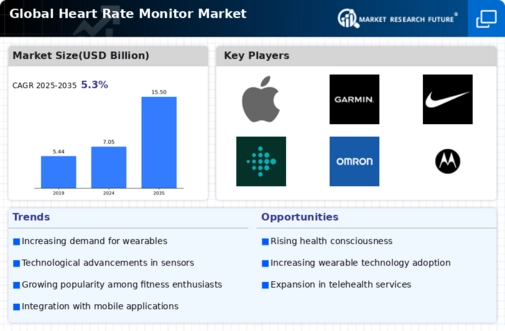Market Trends
Key Emerging Trends in the Heart Rate Monitor Market
The demand for heart rate monitors in the United States has been witnessing a notable surge, reflecting a growing awareness and emphasis on personal health and fitness. Heart rate monitors, once primarily associated with medical settings, have become increasingly popular among fitness enthusiasts, athletes, and individuals looking to monitor their cardiovascular health. This heightened demand can be attributed to several factors, including the widespread adoption of wearable technology, increased health consciousness, and a growing trend towards preventive healthcare.
The widespread adoption of wearable technology, such as fitness trackers and smartwatches equipped with heart rate monitoring capabilities, has significantly contributed to the escalating demand in the US heart rate monitor market. These devices offer users real-time data on their heart rate, allowing them to track and analyze their cardiovascular activity during various physical activities and throughout the day. As the market continues to witness innovations in design, functionality, and connectivity, consumers are increasingly incorporating these wearables into their daily lives, contributing to the overall demand for heart rate monitoring solutions.
The growing health consciousness among individuals has played a pivotal role in driving the demand for heart rate monitors. As people become more proactive about their well-being, there is a heightened interest in monitoring key health metrics, with a specific focus on heart health. Heart rate monitors provide a convenient and accessible way for users to gauge their cardiovascular fitness levels, set fitness goals, and make informed decisions about their exercise routines. This shift towards a health-conscious lifestyle has created a substantial market for heart rate monitors catering to a diverse range of users, from casual fitness enthusiasts to dedicated athletes.
Preventive healthcare has become a focal point in the contemporary approach to well-being, and heart rate monitors play a crucial role in this paradigm. By providing users with insights into their heart rate patterns, these monitors empower individuals to identify potential irregularities or fluctuations, prompting timely intervention and consultation with healthcare professionals. The preventive aspect of heart rate monitoring aligns with the broader trend of proactive health management, where individuals seek to address health concerns before they escalate, contributing to the sustained demand for heart rate monitors in the US market.
The integration of advanced features in heart rate monitors has further fueled their popularity. Many devices now offer additional functionalities, such as sleep tracking, stress monitoring, and GPS capabilities, providing users with a comprehensive understanding of their overall health and fitness. This multifunctional approach caters to the diverse needs of consumers, contributing to the appeal and demand for heart rate monitors beyond basic heart rate tracking.
The COVID-19 pandemic has also played a role in accelerating the demand for heart rate monitors, as individuals became more focused on maintaining their health and well-being. The pandemic underscored the importance of staying physically active and monitoring vital signs, leading to an increased adoption of fitness technology, including heart rate monitors, as part of home-based fitness routines.



















Leave a Comment